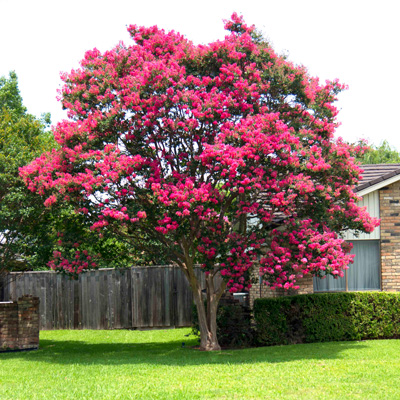Question of the Week Number 2: July 6, 2017
“Neil, why are my neighbor’s crape myrtles blooming beautifully while mine are not?”

Photo: Can you imagine living across the street from this magnificent crape myrtle specimen? (I photographed it in Plano a week or two ago.) That neighbor’s plant is blooming like this, and your plant is doing a big Zero! How depressing would that be? It might cause you to start asking questions!
I gave a general Garden Tip about crape myrtles on my Facebook page five days ago. My FB friends about pounded their fingers to a pulp asking this very question. I know I addressed it in our June 15 issue of e-gardens, but here is my updated and slightly adjusted information.
Reasons crapes myrtles aren’t blooming as of July 6:
1. They were topped. Anyone who tops a crape myrtle in the winter not only ruins its shape forever, but they also slow down its first bloom of the summer by 4 to 6 weeks or more. Do not top crape myrtles!
2. They suffered freeze damage. Several varieties of crape myrtles were hurt by the one bad cold spell early in January. That list is always the same: Tuscarora, Sioux, Natchez, Muskogee and Country Red. Some of these varieties were killed entirely to the ground in the DFW area, for example. By now their new shoots that have emerged from the ground are 5 to 6 feet tall, but they’re obviously going to be late to come into bloom. You need to use long-handled lopping shears to prune out the dead wood so you can train the best of the new shoots to become your new trunks.
3. Variety selection. We have planted more than 100 varieties of crape myrtles (more than 20,000 plants) as a part of our big Crape Myrtle Trails of McKinney project over the past 18 years. Year after year we see the same varieties blooming first and the same other varieties having their first blooms last. Muskogee comes into bloom in McKinney (North Central Texas) in May (sometimes early May), while Country Red doesn’t produce its first flowers until mid- or late July each year. Maybe you have varieties that are later to bloom.
4. They’re in too much shade. Crape myrtles need full sunlight. If they get more than a few hours of shade each day, you will see an immediate drop-off in production of flowers. If more than half a day of shade, kiss the crape myrtle flowers goodbye.
5. They need more water and nitrogen. Many parts of Texas have had good rainfall, but some areas have not. Crape myrtles produce flower buds on new shoots, so apply nitrogen to keep them growing actively. That will ensure better blooming.
